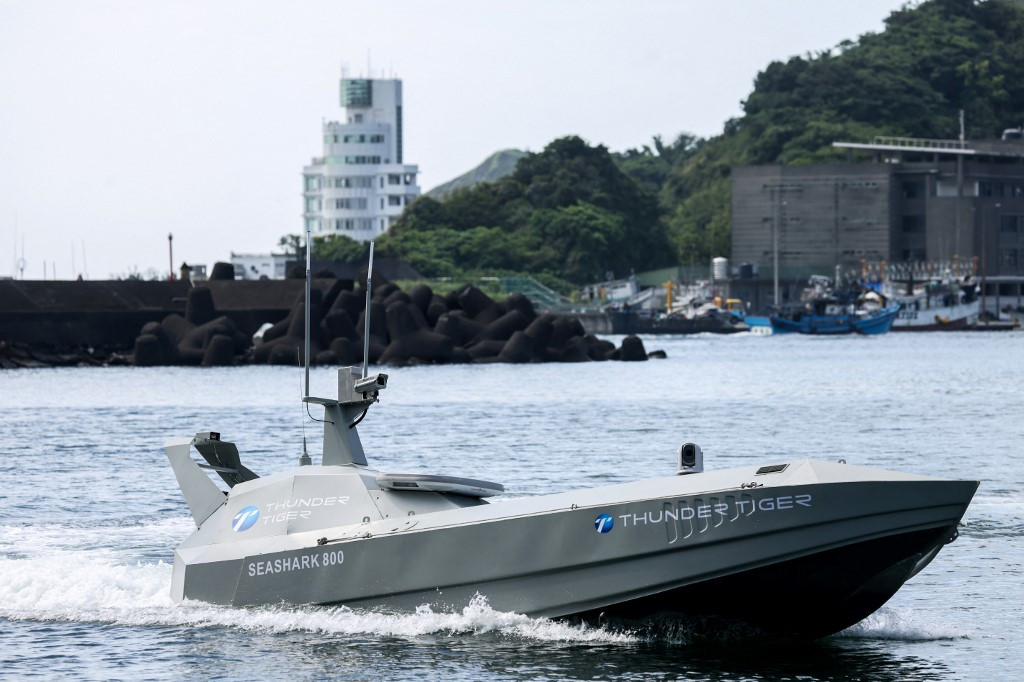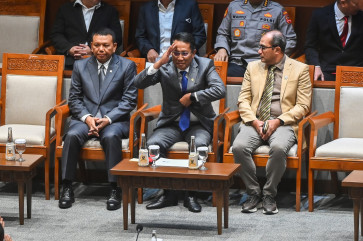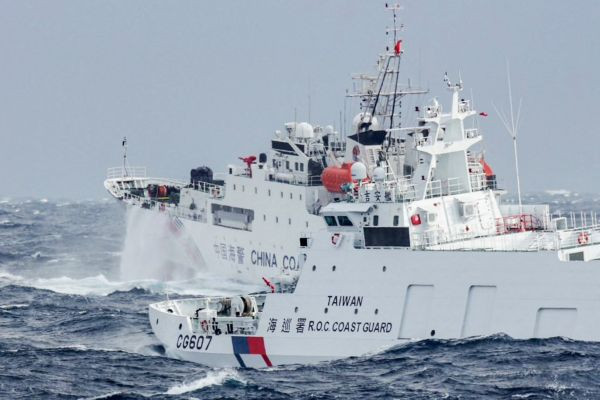Popular Reads
Top Results
Can't find what you're looking for?
View all search resultsPopular Reads
Top Results
Can't find what you're looking for?
View all search resultsDefense tech revolution redefines future battlefield
Unmanned systems and the AI that increasingly operates them are redefining a defense sector more often known for huge delays and cost overruns.
Change text size
Gift Premium Articles
to Anyone
A
s the billionaire founder of one of the world’s fastest-growing defense technology companies visited Taiwan earlier this month, he had a stark message for the island’s next generation of IT engineers: In the face of a mounting threat from mainland China, the survival of their democracy might well depend on them.
In Asia for the opening of a new office in Taiwan and agreement of a production deal with South Korea, Anduril chief executive and founder Palmer Luckey also announced the delivery to the island of Anduril’s Altius “loitering munitions”, within six months of the contract being signed, he said.
It was a reminder of the way in which unmanned systems and the artificial intelligence that increasingly operates them are redefining a defense sector more often known for huge delays and cost overruns.
Such systems have created a new generation of “defense tech” whose political connections are often as significant as the new technology they wield.
But Luckey’s speech to Taiwan’s Artificial Intelligence Academy at its national university on the outskirts of the capital made a rather different point.
It was that Taiwan itself must also move forward with its own defense technology revolution, emulating Ukraine where hundreds of small firms have proven crucial to national survival against Russian invasion by building hundreds of thousands of combat, strike and surveillance drones every month.
The weaponry as well as systems produced by firms like Anduril are fast becoming central to United States-led strategic planning in both Europe and the Pacific. They are now already tested in battle in Ukraine and increasingly critical to the plans of US commanders to defend Taiwan if it is attacked by China – or indeed if Russia attacks deeper into Eastern Europe.
Manufacture of solid rocket motors – a key part of both air defense and longer-range strike missiles now increasingly in demand – was hitherto largely the preserve of longer-established defense firms like Northrop Grumman and Finland’s Nammo. Anduril is just one of several incoming new entrants to that market.
Multiple firms ranging from established “defense primes” to start-ups are also now working fast to build and scale unmanned systems at sea, including surface and subsurface vessels, with some of the firms looking to strike deals with major shipyards to deliver mass production ahead of enduring any major conflict.
How many of those firms will truly survive and thrive, however, remains unclear – as does the balance between established “defense primes”, the new “defense tech” giants led by Palantir and Anduril, and the thousands of much smaller firms vying for their own piece of the action.
How fast that weaponry is truly developing is also a mixed picture. What is clear is that while many of those systems are not yet in service, those that are have already become increasingly central to US and allied military planning.
This summer’s collision between two drone vessels from rival manufacturers in US Navy trials, later leaked to Reuters, pointed to the challenges of taking such technology to the next level by making the unmanned systems more autonomous.
Sources told Reuters the incidents appear to have prompted the US Navy to indefinitely pause a $20 million contract with L3Harris, the sixth largest defense contractor in the US. The firm itself declined to comment.
That, however, is unlikely to stop the race to invest in and embrace such systems. In Europe, analysis firm Taylor Wessing estimated that roughly 10 percent of all venture capital investment in 2024 went to defense systems, many of them also high-tech.
Although the much larger US venture capital market means that while the proportion going to defense is likely smaller, the overall numbers are much bigger – all leading to rapid growth in the US and allied nations.
Anduril’s latest funding round in June saw it raise $2.5 billion in return for equity that valued the company itself at more than $30 billion, roughly twice its estimated value as recently as 2023.
Palantir, founded in 2004 by billionaire Peter Thiel – whose capital “Founders Fund” is also a major Anduril investor – has also seen its share price rocket this year to take its own valuation to more than $250 billion.
Palantir has been at the heart of much of the Pentagon’s embrace of AI for analysis and targeting, particularly its Project Maven in which the company has worked with multiple other contractors to greatly boost the number of targets to be generated for weapons systems such as HIMARS long-range rockets.
The past week, however, has seen it lose at times roughly 20 percent of its market value: The Economist described Palantir as the most overvalued company in the world.
Palantir is reportedly looking to grow beyond the defense sector to tap much wider opportunities but appears to be resisting the temptation to follow other defense tech firms into making actual weaponry.
For others, however, that remains the perceived area of maximum opportunity, particularly with almost all more established Western defense projects from warship and submarine building to aircraft and missile manufacture often suffering heavy delays and budget overruns.
The biggest growth, though – as well as the greatest innovation – may well be in the nations and regions that judge themselves most at risk of possible attack.
In Finland, drone and electronic warfare firms increasingly attend paintball tournaments to test their skills against each other as part of wider simulated battles – while in Estonia, several tech millionaires who made their money in prior decades are now investing heavily in new defense technology.
Finland and Estonia both have a long border with Russia.
Many of those firms are now working directly with Ukrainian counterparts and will be showcasing their work at the Brave1 arms fair in the western Ukrainian city of Lviv next month.
While many of Ukraine’s drones have components built in China, Taiwan has stipulated that none of those it is purchasing can contain parts built on the mainland.
Taiwanese Major General Lou Woei-jye told a news conference on Monday that Taiwan was now following the US in reclassifying smaller drones as "ammunition". That means they will be judged expendable and expected to be used in large quantities from the start of a conflict.
Taiwan also announced this week that it aims to procure almost 50,000 drones of multiple types over the next two years. If it comes to a Chinese invasion, though, the experience of Ukraine suggests that might not be enough.
---
The writer is a columnist for Reuters. The views expressed are personal.











